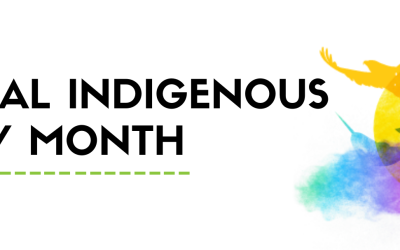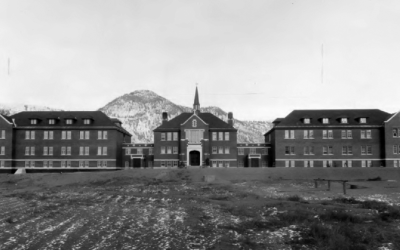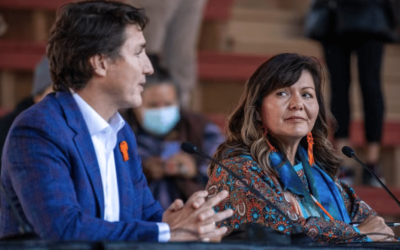On a Saturday afternoon that presented me with a few idle hours, I sat down on the living room sofa to watch director James Mangold’s 2007 film, 3:10 to Yuma, starring Russell Crowe, Christian Bale, and — oh my goodness! — Peter Fonda in a supporting role. I’d popped the DVD into the player because a good action film that pitted the good guys against villains with six shooters seemed like an entertaining way to divert my mind from the heavy-duty reading matter in J.R. Miller’s book Residential Schools and Reconciliation.
And just about any film starring Russell Crowe is worth viewing.
I’d enjoyed this movie before, but quite a few years had gone by, and I was quite surprised at how complex and nuanced was the movie’s plot. The storyline — if you haven’t watched this rather fine remake of a 1957 Western starring Henry Fonda and Van Heflin — focuses on the attempt of Dan Evans, a desperate homesteader played by Christian Bale, trying to get money to save his ranch by signing on to escort and guard a legendary stage coach robber Ben Wade — the Russell Crowe character — to the town where the 3:10 train will take him to Yuma’s territorial prison and almost certain hanging.
As I watched the plot unfold, the vivid contrast between old-style Westerns of my youth and this complex and very human story got me thinking back to the book I’d just been reading. Perhaps, I thought to myself, as not everyone is up to poring through Jim Miller’s well-researched and very detailed examination of the IRS system, a viewing of this film might be be a good alternative for Canadians who want to better understand the many facets of intention, circumstance, fallibility and morality, the very human story, that a close inspection reveals about the history of Canada’s Indian Residential School system.
Think I’m being fanciful? Just try to suspend your fixed ideas and possible prejudices for a moment, and consider the complexity and nuance that the 3:10 to Yuma screenplay adds to the traditional “good guy – bad guy” Western.
Dan Evans, the homesteader whose ranch is suffering from prolonged drought, is portrayed as a very decent man in a situation that compels him to take certain drastic actions. Desperate for money to repay a loan and save his ranch, he also suffers from the knowledge that his wife and oldest son are losing faith in him. He is seriously conflicted about the way he sees the hardened, even ruthless criminal Ben Wade, a man who has carried out numerous stage coach robberies, and who can calmly shoot a confederate who has made a serious mistake. But as the plot unfolds, we see this notorious criminal display a code of honour that prevents him from doing harm to innocent people, and a tenderness with vulnerable women.
And Evans gradually sees this too. Offered a very tempting $200 by the stage coach company, he attempts to bring the notorious robber to justice without letting harm come to him along the way. During the journey — so often used as a metaphor for life — Evans comes to recognize and even respect the positive aspects of Ben Wade’s character, and he develops a personal bond with the man he is bringing to his hanging. By Evans’ bravery and strength of character, he ultimately wins the respect of his more hot-headed son, but at the cost of his own life.
Not very much like an episode of The Lone Ranger, is it? Even the original 3:10 to Yuma was, for its time, remarkably nuanced in its “take” on the traditional Western. One review of that film opines that it is “distinguished by its thoughtfulness regarding the nature of Western heroism, as defined not only by dead-eye gunplay, but by family, community, and moral rectitude.”
As with the 1957 version, all kinds of complexities are built into the 2007 re-make, reminding us that real-life interactions of this sort back in the 1800s would not have been at all unusual. While Zane Grey novels, Hollywood movies, and early TV shows tended to paint the opening up of the West in shades of black and white, what really happened was far more like the events portrayed in both versions of 3:10 to Yuma — full of complexity, full of human interactions that significantly affected decisions and even policies, full of very human emotions.
Now consider the creation and operation of Canada’s Indian Residential School system. Created in the late 1800s, it was supervised and staffed by individuals who held and promoted certain views, made decisions both trifling and major, and took action from a mix of personal beliefs, bureaucratic and administrative considerations, not to mention a keen awareness of public opinion. Reading the documents of the time, one repeatedly sees statements that indicate a desire considered both sensible and humane to bring the Aboriginal portion of the newly-formed nation into the mainstream of what was then “modern” life, making “the Indians” into “white men” who would thrive or flounder along with all the other Canadians.
What resulted from those beliefs, decisions, policies and actions was likewise a mix of incompetence and ability, confusion and clear-headedness, self-interest and benevolence, cruel predation and admirable self-sacrifice. Some good was done, some harm was done — how much of each remains unclear. Even the Truth and Reconciliation Commission, with its multi-year mandate and its multi-million dollar budget, could not establish that in any clear manner.
But one thing is very clear: the overall result of creating the residential schools was only partially what the system’s creators and administrators had envisioned. While individual IRS students benefited from their schooling, and some went on to make important contributions to their people and to the nation, the damage done to native families and communities was considerable. Like so many other government programs, the IRS system suffered from a lack of consultation with those affected by it, a failure to grasp some basic flaws in the rationale and operation of the system, and all-too-frequent underfunding.
Watching 3:10 to Yuma, I couldn’t help seeing the homesteader Dan Evans as a representative of the many well-meaning, determined, but conflicted Canadians who served in the Indian residential schools, employed as teachers, supervisors, administrators, and support staff. Some of them — particularly the Indigenous among them — must have known that the policies and practices of the more repressive schools were inflicting damage on individuals, families, and communities. But compassion and a sense of duty — “What will happen to these children if they don’t get an education?” — plus the knowledge that, left in their home communities, the children would likely fare worse than they would in residential care, doubtless sustained them in moments of doubt. Just as Dan Evans assures himself that he’s doing the right thing while increasingly getting to like and respect the notorious Ben Wade, IRS staff and officials in the Department of Indian Affairs must have struggled with their consciences whenever they knew children were being taken from their families against their will, with the misery that such a sudden and forcible loss of a family member would entail. But it was a conviction that they were “doing the right thing” that made them persevere.
And there is another complication in the story of the Indian residential schools. There can be little doubt that, as in so many cases, the flawed government program was arguably better than no program at all. There existed no practical and fiscally-feasible alternatives to the idea of residential schooling — just finding reasonably competent teachers for the hundreds of federal day schools was already very difficult — and had the IRS system not been established, the fate of Canada’s Indigenous people might have been far, far worse. It is instructive that no credible alternative to the residential schools has ever been put forward.
Canadians need to know about the flaws, failures, and harms of the Indian residential school system, but creating the equivalent of an old-fashioned Western movie, full of innocent folk up against heartless “bad guys”, does not advance the cause of Indigenous people today, and in fact will ultimately erode whatever credibility native leaders, activists and their supporters might have. Millions of “ordinary” Canadians simply don’t buy the black-and-white version they’re being handed, and just as millions of gun-toting Americans happily accepted the version of the Old West that suited their political views, those who do accept the current narrative without question will unfortunately make decisions based on a cartoon, a graphic novel, a headline.
And it is that kind of ill-informed, blinkered and agenda-driven decision-making that got us into this deplorable situation in the first place.
Read the PDF version here: EF29ComplexityNuanceTruthDeWolf



